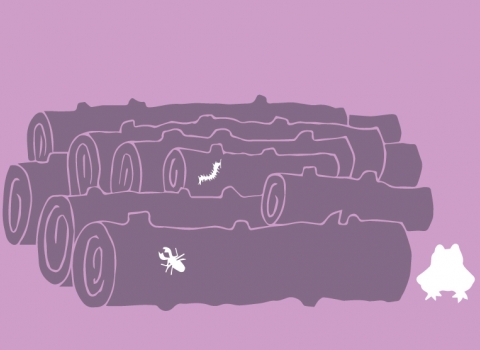Log piles are perfect hiding places for insects, providing a convenient buffet for frog, birds, and hedgehogs too!
Putting together a log pile will create a village for all things creepy and crawly. In turn, this busy community will attract birds, hedgehogs and frogs looking to snack on a tasty morsel.
You will need
- Logs! You can get them from tree surgeons or firewood dealers. If you’re lucky, some pieces may already contain beetle grubs which could hatch and populate your garden. Native wood is best, but anything will do.
Building your log shelter:
You can build up the logs to form your ‘minibeast village’ in a variety of ways:
- Scattered: Scatter your logs in a flower border or under a hedge. Like this, they are handy for keeping plants apart and mulching the soil, but you’ll get more wildlife if you do create a concentrated stack.
- Neat and tidy pile: Tidy stacks are often seen in coppiced woodlands. Logs are carefully piled on top of each other, often forming a pyramid.
- Higgledy-piggledy: The ‘natural’ way to do it, and great for architectural impact. But it doesn’t create much shade.
- Organ pipes: Sunken wood creates the most micro-climate possibilities.
- Giant cheese: If you can get a real ‘wagon wheel’ log, it will create the most stable environment of all underneath. Superb for amphibian hibernation.
This busy community will attract birds, hedgehogs and frogs looking to snack on a tasty morsel
The stars of the show...
- Devil's Coach Horse (Staphylinus olens): Ferocious, predatory beetle that curls its tail up in defence – even at humans! Great for the garden, it eats invertebrates and pests like vine weevil. It can deliver a painful nip, however, so handle with care!
- Brown Centipede (Lithobius forficatus): Up close, its honey-brown, segmented body hosts just 15 pairs of legs, despite its name! This predatory invertebrate has poisonous claws and large, biting jaws to catch its prey, but is harmless to humans. It may live for four years.
- Violet ground beetle (Carabus violaceus): A nocturnal predator that chases and catches smaller invertebrates; they are particularly helpful to gardeners as they prey on many 'pest' species, such as slugs. Found resting during the day under logs and stones.
- Common Woodlouse (Oniscus asellus): A familiar minibeast, it is an important recycler of nutrients, feeding on decaying matter. It also provides prey for birds and the specialised Woodlouse Spider, whose jaws can even pierce human skin!

